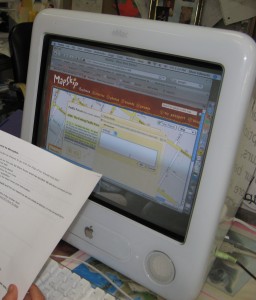 How powerful is global collaboration? Sue Waters asks this. Even small projects can prove beneficial in more than academic ways.
How powerful is global collaboration? Sue Waters asks this. Even small projects can prove beneficial in more than academic ways.
I’ve just blogged a reflection on an ongoing project between my fifth graders in Nespelem, Wa and Kim Trefz’s fifth grade in Memphis, Tennessee to share the goals and results of a serendipitous Web 2.0 meeting of minds. I read an intro to a new edublog on twitter, which linked to her classroom blog, which included a voice thread. I commented and we emailed. Twenty hours later, Kim and I had Skyped and decided to collaborate. We’ve centered our work around a wiki idea: Living History. To meet each of our schools’ requirements, we’ve adapted as the needs demanded. We skyped an exhibition of our Native American dancers (please read blog) and bookmarked historical text and videos about our bands. They researched and wrote about Memphis in wiki and Mapskip entries. We then highlighted main ideas and commented with Diigo, and revised the comment in Mapskip. Her students are commenting back. Her reflection is here.
We’ll be starting up wiki collaboration after our respective Spring Breaks. It’s been an opportunity for both our classes to build commonalities despite our differences, all through the power of writing and learning with Web 2.0.
My eighth grade students respond to a mentor, preservice teacher from the University of Regina in Regina, SK, Canada who is creating photography lessons for my students. We annotating pictures to add to a project in Youth Voices, a youth blogging site.
My fifth grade students watched the inauguration of Barak Obama and heard his call for service. Therefore, we started a VoiceThread for which two other schools have now added their voice for “Mr. Obama, we can serve by…”
The sixth graders just started a mentorship with another University of Regina preservice teacher on newsblogging.
I became involved because students love the computer, and writing class is a natural place for being IN web 2.0 responsibly with its fullest capacity: text, images, video, design.
My students are more engaged in learning through the empowerment of a digital footprint with others so far away who have similar goals (writing to publish, service) but come from different backgrounds and experiences. Because we live in a very rural area, now my students begin to understand similarities in a world of multiple perspectives; they think, care, and produce as responsible, digital citizens. These projects help meet our school mission: “to enable a child to become a thinking, caring, productive person using high academic standards in a positive learning environment.”
Flexibility is key to such projects, especially in the beginning, so that participants can engage while learning the schools’ required objectives. Dive in is the next key. Kim had not skyped before, but signed up that night, emailed me her name, and I skyped her to test it out the next morning, not knowing it was her staff meeting time. She introduced the Mapskip aspect to us. It was an exciting adventure that just blossomed for all of us. Focus on the global: our overarching goal became sharing living cultures even though our vehicle is writing.
I recently sent this tweet to Kim, which represents the heartfelt side of these projects:
“ktrefz picture this: two of my boys -arms around each others’ shoulders – reading your kids Mapskip comments [back to them]; smiles; joy in their lives; thank you”
This is the joy of leading the change we wish to see in the world. Powerful, isn’t it?
“Be the change you wish to see in the world.” Gandhi
Notes:
Much bolder projects others in which others have succeeded can be found at the Flat Classroom Project: http://flatclassrooms.ning.com/
Find other projects at:
Teachers Connecting: http://teachersconnecting.com/
Online Projects 4 Teachers: http://onlineproj4tchrs.ning.com/


Thanks, Sue. I follow your many blogs and tips to help me learn how to be better. Anne’s work is fantastic, another pioneer in the revolution of education today.
Thanks for sharing information on the Global projects you have been involved with and why you engage with them. You information will definitely help me with preparing my presentation. You might also like to check out Anne Mirtschin response.